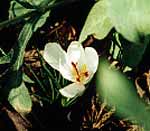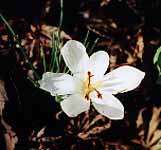
A. E. Bowles' White Autumn Crocus
We planted these in September 2002 & a couple of them bloomed immediately in October & early November, though most of the intended drift produced only their grassy leaves for winter & spring.
 We planted the corms to one side of a Lionshead Maple & in front of 'Egyptian Rose' Knautia, where they get considerable afternoon sun during the autumn & winter once the perennials have died back & the maple has lost its leaves. Because most of this area gets good watering in summer, but the corms after summer die-back would prefer to remain dry for a while, there was always the possibility they would not naturalize as well as is possible, though we counted on their adaptability being sufficient that they might return autumn after autumn.
We planted the corms to one side of a Lionshead Maple & in front of 'Egyptian Rose' Knautia, where they get considerable afternoon sun during the autumn & winter once the perennials have died back & the maple has lost its leaves. Because most of this area gets good watering in summer, but the corms after summer die-back would prefer to remain dry for a while, there was always the possibility they would not naturalize as well as is possible, though we counted on their adaptability being sufficient that they might return autumn after autumn.Blooms for this strain are medium chalices larger than average for the species but not as large as other autumn crocuses. It is white with red-tipped yellow anthers, held comparatively far aloft on a floral tube that serves as a stem.
Some strains are lilac, but ours is mainly snowy white, a clone from the English garden of E. A. Bowles. Bowles provided nurseryman John M.C. Hoog the orginal stocks that were preserved as a selected strain of this botanical crocus. "Gussie" Bowles was one of the world's leading authorities on crocuses & he literally wrote the handbook for them. Bryan Hewitt has written a biography on him, The Crocus King.
I copied down Gussie's list of the "easiest" of the Autumn-blooming crocuses, & the ones I didn't already have I soon obtained. The four easiest are: C. speciosus, C. pulchellus, C. longiflourus & , C. zonatus. The last-named is now known as C. kotschyanus ssp kotschyanus, & corms should be obtained only from specialists willing to guarantee bloom, as many mass-produced corms never do bloom, ever. C. niveus alas was not on that list of the ones which are nearly foolproof, but isn't supposed to be terribly difficult so I keep my fingers crossed even though they've done very little so far.
The Bowles strain is supposed to be hardier than most against frost, & a bit more inclined to naturalize down to zone 6. The species is native of warm southern Greece (the Pelopenessus), & track their seasons not so much by cold winter & warm summer, but by wet spring & dry summer, hence are easily confused in a fairly even-temperatured zone such as ours, with year-round rainfall, & may as a result bloom somewhat eratically rather than at a predictable time in winter.